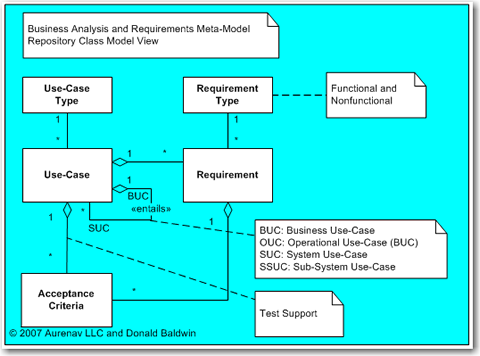Unified Process for Enterprise Solution Engineering (UPESE)
The UPESE framework provides a Use-Case and architecture driven agile methodology for both program and project based IT solutions. The UPESE combines the Unified Process with Systems Engineering and Program and Project Management methodologies. UPESE is based around the Rational Unified Process (RUP), the Rational Systems Engineering (SE) plug-in for RUP, and a management extension based on both the PMI and PRINCE2 methodologies (Aurenav has developed several management configurations for the UPESE for use with MS Visio 2003 or later, Rational XDE, Rational Rose Enterprise, Rational Software Architect, Rational SoDA, and Sparx Systems Enterprise Architect that support the ICCP PPM framework, the PMI framework, or the OGC Program and PRINCE2 Project frameworks).
The UPESE supports business, operational, system and sub-system use-cases as illustrated in the model above. The UPESE metamodel also supports any other types of use-case (e.g. Essential Use-Cases, Usage-Centered Use-Cases, etc.).
The UPESE is based on UML 2.x and supports MDA UML Profiles as illustrated in the diagram above. Profiles provide a strategy for realizing common component, transformation and routing functionality within an enterprise by establishing a standard for messages and objects for use on the platform. Such a standard is referred to as a profile in Model Driven Architecture (MDA). Working with the Object Management Group (OMG), the Enterprise Systems Architecture Laboratory has refined these profiles into seven layers:
- Application Design Profiles – Applications that comprise enterprise (vertical) application components and (horizontal) integrated application solutions.
- Application Profiles – Vertical domain profiles for components and applications with supporting specialized domain architectural description languages.
Examples include transportation, telecommunication, and healthcare domains.
- Platform Implementation Profiles – Development platform profiles from which applications are built.
Examples include J2EE, .Net, and CORBA.
- Data Management Profiles – Profiles that define identification, control, policies, and procedures for managing data, typically adopted by standards organizations, that are formally defined.
Examples include CWMI, MIS/EIS, and Database standards (i.e. RDBMS).
- UML Standard Profiles – Infrastructure templates, typically adopted by standards organizations, that are formally defined.
Examples include real-time, middleware, and embedded standards.
- Data and Metamodel Profiles – Provides the capability to extend the UML through existing standards in order to represent UML designs in a stored data repository and to provide a mechanism to describe all database representations and interfaces.
- Core UML Support Profiles – Unified Modeling Language (UML) notation coupled with an Object Constraint Language (OCL) and supporting methodology.
Copyright © 2024 All rights reserved. Aurenav LLC.
 Print
Print
